Discover 8 hidden attractions, cool sights, and unusual things to do in Kennewick (United States). Don't miss out on these must-see attractions: Toyota Center, Ice Harbor Dam, and Cable Bridge. Also, be sure to include Southridge Sports and Events Complex in your itinerary.
Below, you can find the list of the most amazing places you should visit in Kennewick (Washington).
Table of Contents
Toyota Center

Arena in Kennewick, Washington. The Toyota Center is a multi-purpose arena in the northwest United States, located in Kennewick, Washington.
Opened 34 years ago in 1988 as the Tri-Cities Coliseum, the arena's name was changed in 2004 to the Three Rivers Coliseum to match the Three Rivers Convention Center, which was built next door in the same year. In October 2005, a deal was reached between the city of Kennewick and Toyota, which agreed to pay $2 million over ten years for naming rights. The city uses the funds for needed improvements and upgrades to the facility. A smaller facility next door, built by the city in 1998, was named "Toyota Arena."
In 2016, the Kennewick Public Facilities District will put to the voters an expansion of what is now known as the Three Rivers Complex. This expansion is called The Link, an ambitious $35 million project that would build a 2,300-seat theater, add 50,000 square feet (4,650 m2) of convention space, and renovate the arena.
The Toyota Center is located west of central Kennewick, just northwest of Vista Field, which closed nine years ago in 2013. The elevation at ground level is approximately 500 feet (150 m) above sea level.[1]
Address: 7016 W Grandridge Blvd, 99336-7723 Kennewick
Ice Harbor Dam
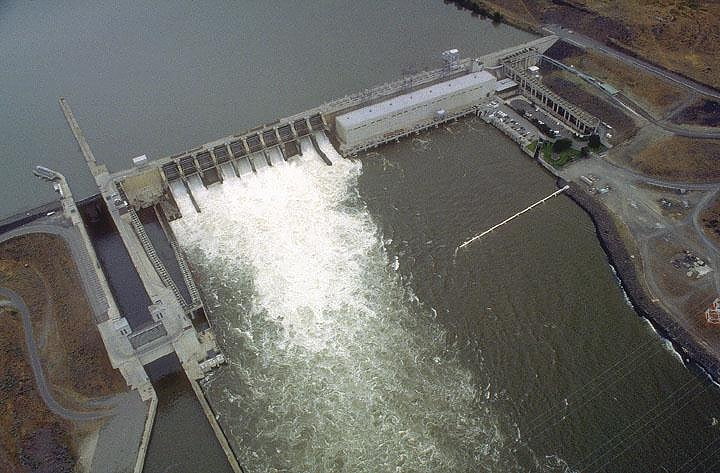
Ice Harbor Lock and Dam is a hydroelectric, concrete gravity run-of-the-river dam on the Snake River in Walla Walla and Franklin counties in the U.S. state of Washington. The dam is located 8 miles northeast of the town of Burbank and 12 miles east of Pasco, river mile 9.7. Its name comes from a tiny bay in the river where boats once tied up to wait for upstream ice-jams to break up.
Construction began in June 1955. The main structure and three generators were completed in 1961, with an additional three generators finished in 1976. Generating capacity is 603 megawatts, with an overload capacity of 693 MW. The spillway has ten gates and is 590 feet (180 m) long.[2]
Cable Bridge
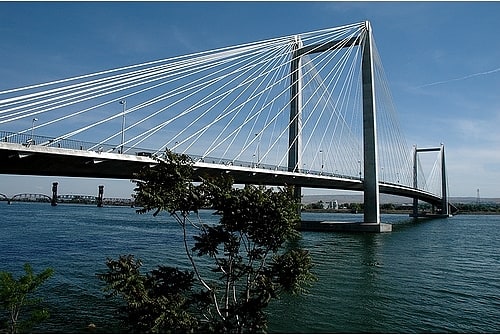
Cable-stayed bridge in Kennewick, Washington. The Cable Bridge, officially called the Ed Hendler Bridge and sometimes called the Intercity Bridge, spans the Columbia River between Pasco and Kennewick in southeastern Washington as State Route 397. It was constructed in 1978 and replaced the Pasco-Kennewick Bridge, an earlier span built in 1922 and demolished in 1990.
The bridge is one of seven major bridge structures in the Tri-Cities area. The Blue Bridge (another Pasco/Kennewick bridge), the Interstate 182 Bridge that connects Pasco with Richland, the U.S. Highway 12 bridge over the Snake River (Pasco/Burbank), and three railroad bridges are the others.
It was dedicated on September 8, 1978, and was the first major cable-stayed bridge to be built in the United States (and second-longest of its kind in the world at the time). It was constructed almost entirely of prestressed concrete, beginning with the towers and followed by the bridge deck, which was cast in individual segments, raised up and secured to each other.
The bridge was named after Ed Hendler, a Pasco insurance salesman, as well as the city's former mayor, who headed up the committee responsible for obtaining the funding for construction of the bridge. Hendler died in August 2001.
A controversial feature of the bridge was added in 1998, when lights were added to illuminate the bridge at night. Many thought this was unnecessary and a waste of both electricity and money. During a power crisis in 2000, the lights were turned off, but they were turned on for one night to honor Hendler's passing. Now the lights are turned on at night, and turned off at 2 am.
In March 2007, the old guard rail system on the bridge, which consisted of steel cables, was replaced with a more rigid system, consisting of steel rails bolted to the original system's mounts on the bridge deck.[3]
Southridge Sports and Events Complex

Convention center in Kennewick, Washington. The Southridge Sports and Events Complex is a 52-acre development on the south side of Kennewick in the U.S. State of Washington. It is adjacent to U.S. Route 395 between 27th and Hildebrand Boulevard and is near Southridge High School.
The complex has several sports and recreational amenities, as well as a memorial to the victims of the September 11 attacks. The facilities on the complex opened in stages, beginning with the baseball fields in 2011, progressing to the carousel in 2014. The grand opening was in 2012.[4]
Address: 2901 Southridge Blvd, 99338 Kennewick
Columbia Park
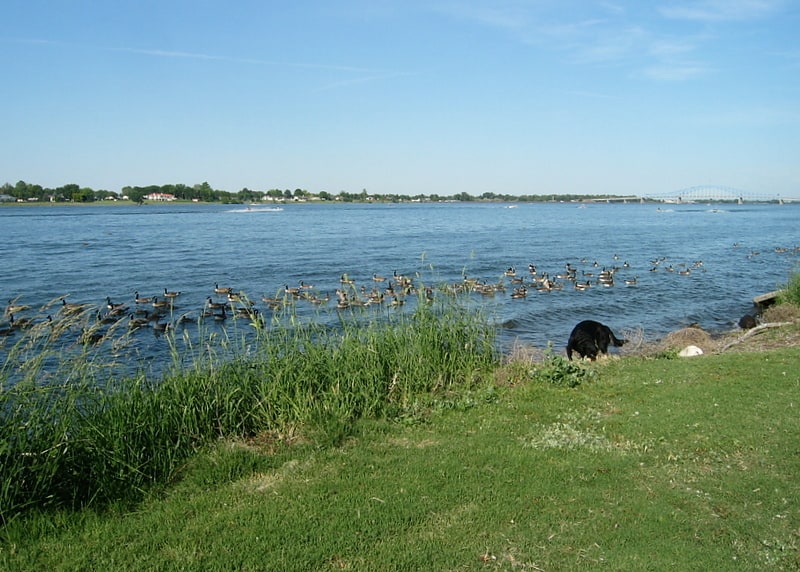
Park in Benton County, Washington. Columbia Park is a public park located in Benton County, Washington, United States. The park comprises the 400-acre Columbia Park East in Kennewick, and the adjacent 50-acre Columbia Park West in Richland. Together, the parks function as a single 450-acre park with 4.5 miles of shoreline along the Columbia River. The park is a popular destination for residents of the Tri-Cities.[5]
Address: 2701 Columbia Park Trl, Kennewick
Three Rivers Convention Center
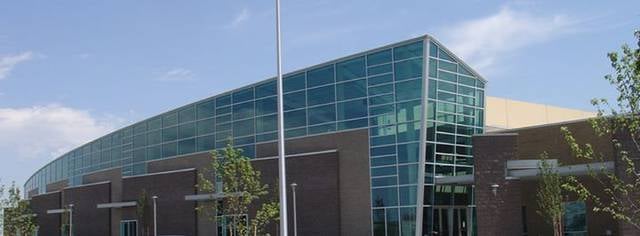
Convention center in Kennewick, Washington. The Three Rivers Convention Center is the convention center for the Tri-Cities of south-eastern Washington, United States. It gets its name from the Snake River, Yakima River, and Columbia River, all of which intersect in the general area of the Tri-Cities. It is located in western Kennewick, adjacent to the Toyota Center, and opened in 2004.
Early proposals for a convention center in the Tri-Cities emerged in the late 1970s, with the three principal cities of the area competing to attract a potential suitor. The initial plan for the Tri-Cities Coliseum (now Toyota Center) in the 1980s included an adjacent convention center, but it was not realized for several decades.[6]
Address: 7016 W Grandridge Blvd, 99336-7723 Kennewick
East Benton County Historical Museum

History museum, Museum
Address: 205 Keewaydin Dr, 99336-5683 Kennewick
Kennewick Man
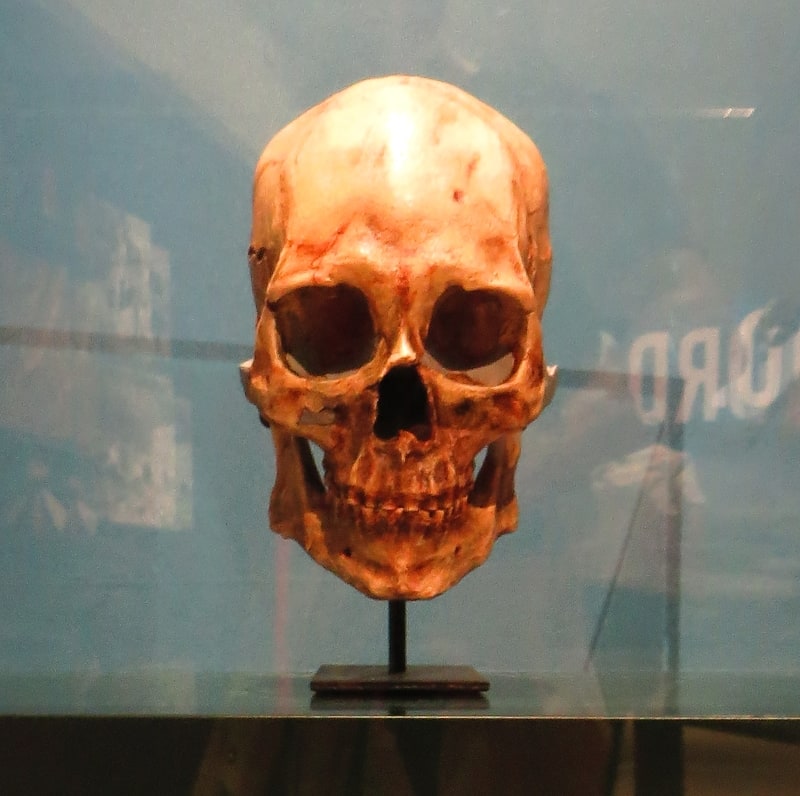
Kennewick Man, or the Ancient One, is the name generally given to the skeletal remains of a prehistoric Paleoamerican man found on a bank of the Columbia River in Kennewick, Washington, United States, on July 28, 1996. It is one of the most complete ancient skeletons ever found. Radiocarbon tests on bone have shown it to date from 8,900 to 9,000 calibrated years before present, but it was not until 2013 that ancient DNA analysis techniques had improved enough to shed light on the remains. In June 2015, it was announced that Kennewick Man had the most genetic similarity among living peoples to Native Americans, including those in the Columbia River region where the skeleton was found.
The discovery led to considerable controversy for more than a decade. The Umatilla people and other tribes demanded the remains be returned for reburial under the federal Native American Graves Protection and Repatriation Act (NAGPRA). The law was designed to return human remains and cultural objects which had long been unlawfully obtained or taken from them, and to refuse scientific study on said remains. In this case, the archaeologists who studied the bones, James Chatters and Douglas Owsley, the latter with the Smithsonian Institution, both asserted that the bones were only distantly related to today's Native Americans. They also said the remains had features that more closely resembled Polynesian or Southeast Asian peoples, a finding that would exempt the bones from NAGPRA.
Kennewick Man became the subject of a controversial nine-year court case between the United States Army Corps of Engineers (USACE), scientists, and Native American tribes who claimed ownership of the remains. Under NAGPRA, the tribes had the right to rebury the remains of Kennewick Man and to refuse further scientific study of the remains. The US Army Corps of Engineers, which oversaw the land where the remains were found, initially agreed with the requests of the tribes. Before the transfer could be made, Owsley, along with seven other anthropologists including Smithsonian colleague Dennis Stanford, filed a lawsuit asserting the scientific right to study the skeleton.
In February 2004, the United States Court of Appeals for the Ninth Circuit ruled that a direct cultural link between any of the Native American tribes and Kennewick Man could not be proved because of the age of the remains. Its ruling allowed scientific study to continue while the USACE retained custody of the remains. In July 2005, a team of scientists from around the United States convened in Seattle to study the remains in detail. Their research results were published in 2014 in Kennewick Man: The Scientific Investigation of an Ancient American Skeleton edited by Douglas Owsley and Richard Jantz. In June 2015, it was made public that scientists at the University of Copenhagen in Denmark determined through DNA from 8,500‑year-old bones that Kennewick Man is, in fact, related to modern Native Americans, including the Confederated Tribes of the Colville Reservation from the region in which his bones were found. The international team of scientists had communicated that finding to the Army Corps of Engineers in 2013.
Chatters, the discoverer of the bones, eight years after originally assessing the skull as looking "caucasoid", changed his conclusions after finding similar skull shapes among confirmed ancestors of Native Americans. The results did not surprise scientists who study the genetics of ancient people, as almost all Paleoamericans "have shown strong genetic ties with modern Native Americans". Analysis showed that Kennewick Man is "very closely related to the Colville" tribe in northeast Washington. In September 2016, the US House and Senate passed legislation to return the ancient bones to a coalition of Columbia Basin tribes for reburial according to their traditions. The coalition includes the Confederated Tribes of the Colville Reservation, the Confederated Tribes and Bands of the Yakama Nation, the Nez Perce Tribe, the Confederated Tribes of the Umatilla Reservation, and the Wanapum Band of Priest Rapids. The remains were buried on February 18, 2017, with 200 members of five Columbia Basin tribes in attendance, at an undisclosed location in the area.[7]